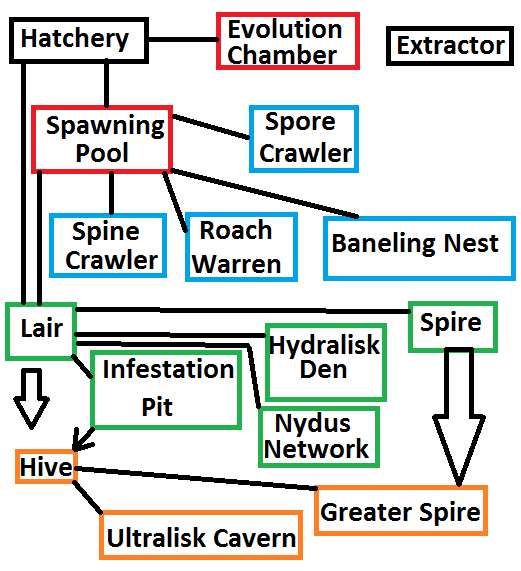Starcraft 2 Zerg Structures ListStarcraft 2 Strategy Guide --> Zerg Guide --> Starcraft 2 Zerg Structures (you are here)
The middle of this page contains two figures. The first is a graphic depicting the Zerg tech tree. This provides a quick overview of what the prerequisites are for each Zerg building. The second figure is a table which provides all the key stats associated with each building: the cost, prerequisites, build time, and what units it allows to morph. Finally, we will end with a section detailing approximately when to get each structure in a typical game. Table of Contents Use the following links to jump quickly to the section you are looking for: Zerg Structure and Creep Mechanics Zerg Structure, Construction and Creep MechanicsThere are a few aspects of Zerg building construction as well as structure and creep mechanics that all players should know. The first thing to understand about Zerg mechanics is how Drones actually make buildings. The construction of any new Zerg structure results in the loss of the Drone. This means that if you wanted to make 10 Spine Crawlers, you would have to permanently sacrifice 10 Drones. The cost of losing Drones is already factored into the cost of Zerg buildings. For example, an Extractor only costs 25 minerals, while the Terran Refinery and Protoss Assimilator each cost 75 minerals. A Spine Crawler costs 100 minerals to the Photon Cannon's 150 minerals. Note that when you place a Drone, the supply cost saved from losing that Drone is immediately available. Cancelling a structure returns the Drone and the supply it costs. If you are at 10/10 supplies and build an Extractor, you will drop to 9/10 supplies. While the Extractor is building, a new Drone could be trained. The Extractor could then be cancelled, allowing the Zerg to go up to 11 out of 10 supplies. While this is not seen as very efficient in the early game, it can be used to boost your supply count beyond 200 once you are maxed out. All About Zerg Creep Another important aspect of Zerg buildings is creep. All new buildings aside from the Hatchery and Extractor must be placed on creep. When a building is on creep, it slowly regenerate health over time. When a building is off the creep (i.e. the building's creep generating source was killed, but the building was not), it will lose HP over time, eventually dying if the creep source is not restored). Creep is supplied via two primary sources: Hatcheries and Creep Tumors. Hatcheries are morphed from Drones while Creep Tumors can be planted by Queens. Creep spreads in an unusual manner. Just more than once per second, a pulse causes a new but very small amount of creep to be generated in a somewhat random pattern from the edges of the current creep spread. This pulse continuously occurs until the full radius is reached. Overlords can also produce creep in small amounts once the Lair is researched if the ability is enabled, but the pulse rate is slower (about 1 second per pulse) and the radius is much smaller). It takes just under a minute and a half for a single Creep Tumor in open space to spread out to all its possible locations. However, typically Creep Tumors are not in open space and will spread faster, as objects like walls can prevent creep spread. Since Creep pulses more than once a second and always forms a new bit of creep, a Creep Tumor placed up against a wall will spread faster since it has less available space for it to spread. When multiple Creep Tumors are placed in the same area, creep spread is faster, as each Creep Tumor gets its own pulse. A Guide to Zerg Larva The final important aspect of Zerg construction is the production facilities. The Zerg's Hatchery, Lair, and Hive all act as the Zerg's production facilities. These structures spawn 1 Larvae every 15 seconds. Larvae is used to morph most Zerg units. A Larvae is consumed each time one of these units is morphed. Larva will continue to generate until there are 3 total Larva at each Hatchery. The Queen's Inject Larva ability can produce 4 Larva every 40 seconds, more than doubling the potential production capacity of a single Hatchery if the player is diligent about casting this ability. A single Hatchery can bank up large quantities of Larva through repeated injects. For example, if a Hatchery with 3 Larva is injected, upon Hatching, there will be 7 Larva available for use. If no Larvae are used and another round of Inject Larva is used, there will be 11 Larva ready for use. The Larvae cap is 19 at a single Hatchery.Note that automatic Larvae generation is turned off once there are 3 Larva at a Hatchery, regardless of how those Larva were generated. To clarify, if you use up all the Larva at a Hatchery right before an Inject Larva finishes, when the new Larva hatch, you will only have 4 Larva, and the Hatchery will not begin to generate Larva again until you use up some of those Larva to get the Larva totals under 3. In order to use a Larvae to morph into a particular unit, the prerequisite tech structure has to be built. Once a Spire is built, Larva at any Hatchery, Lair, or Hive can be morphed into Mutalisks. Since a single tech structure can unlock production from all the Zerg's Larva, it is not very costly for Zerg to switch to a completely different tech path and unit type. This is one of the primary strengths of the Zerg race. Zerg Structure Tech TreeThe graphic below provides a quick overview of the Zerg tech tree in Starcraft 2.
Note that the Hatchery evolves into the Lair and the Lair evolves into the Hive. Getting a Spawning Pool enables the basic Zerg structures. With a Hatchery and Spawning Pool up, Zerg players can be all of their basic structures. Simply getting a Lair enables access to most advanced tech structures, whereas a Hive unlocks the remaining structures. The only oddity is the Greater Spire, which can be evolved from the Spire but only once a Hive is first evolved from the Lair. A Spawning Pool is required to evolve the Hatchery into a Lair while an Infestation Pit is required to evolve the Lair into a Hive. Zerg Structures TableThe table below provides the cost, build time, prerequisites, what each structure can research, and what is unlocked by the construction of each Zerg structure in Starcraft 2.
Zerg Structures: Which and When to BuildZerg structures are unusual in that both the production facility and the harvesting center are the same building. Building additional expansions will automatically give you additional production facilities so that you can spend the extra income your expansion can generate. If your Inject Larva timing is very good, typically you will be fine with having just 1 Hatchery per expansion. If your Inject Larva timing is poor or you are building a lot of cheap units like Zerglings and need extra production capacity, players may throw down a macro Hatchery. This is a Hatchery built next to the main or natural expansion and only exists to provide extra Larva. You only want to build a macro Hatchery if you intend to be very aggressive in the near future or in the late game if you have banked up a lot of resources and need to be able to spend them better. Otherwise, if you are going to use the extra Larva production for more Drones, that extra Hatchery might as well be at an expansion where it can be used to return minerals and gas rather than in your main base where it is only producing Larva. The key thing to remember as Zerg is that every time you build a structure, that is a Drone lost that is no longer harvesting. The resources invested in those structures are resources that are not being invested into more Hatcheries. The gas spent on tech was time those Drones were not spending on harvesting minerals. As a general rule of thumb, the better a Zerg gets, the longer they tend to delay technology. Top Zerg players typically delay tech (and oftentimes the mining of gas) while they race for 3-4 bases, getting up to 70+ Drones before they actually work on tech. Once they build up this robust economy, most if not all tech structures are then planted. With a big economy, it is not a very large investment to get each tech structure. With 4+ Hatcheries, the Zerg player is then able to produce large quantities of whatever unit the current situation demands. The best Zerg players only build structures when they are needed. If you build extraneous structures like the Baneling Nest and Roach Warren and then do not end up using these units in the early game, you just wasted a lot of resources that could have been Drones or more Hatcheries. This is different from the Protoss or Terran because some of these races tech structures also produce their units. Zerg production comes from the Hatchery, so the Zerg player gets to pick what tech structures to build without sacrificing their ability to produce units. Top Zergs are even careful about mining gas in certain builds. These players will get just the right amount of gas for something like a Lair or Metabolic Boost and then go right back to harvesting minerals, only adding gas on once they have added on and saturated their third base. Of course, sometimes players use a particular build or spot a particular weakness that involves teching up early. While not common outside of ZvZ, some Zerg players are able to pull off early tech builds on just two bases. Additionally, Zerg players are much more defensive in ZvZ and do not typically get their third base until later in the game. |
Don't be shy - share this page on G+ and Twitter!
Sign up for my Free Starcraft 2 Mini-Course where I reveal my best strategies not seen anywhere on this site!
Starcraft 2 Strategy Guide Privacy Policy Contact Us Disclaimer
©2013 www.osirissc2guide.com


